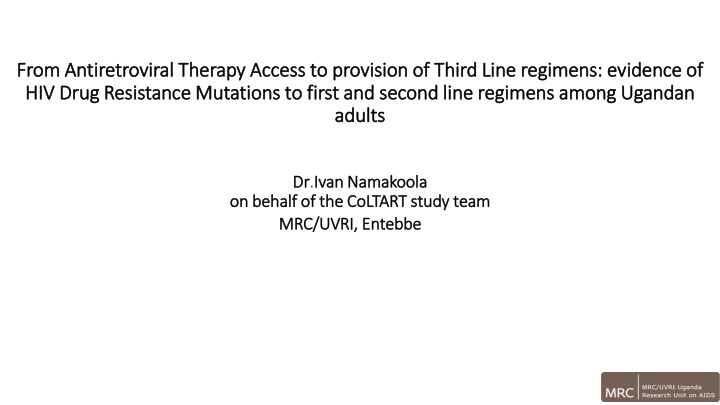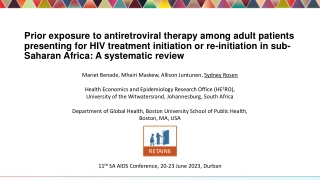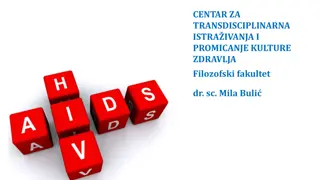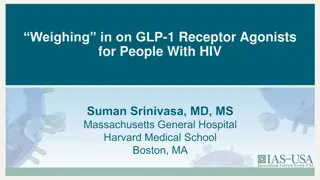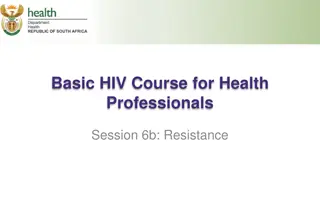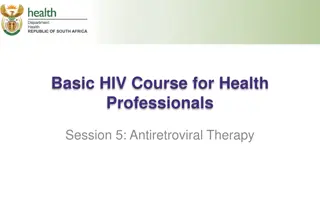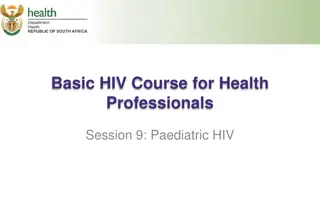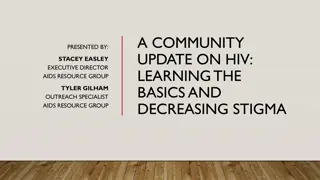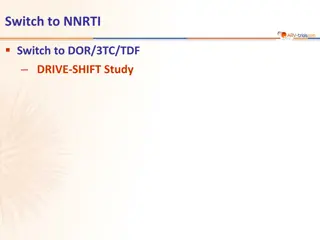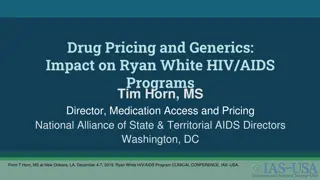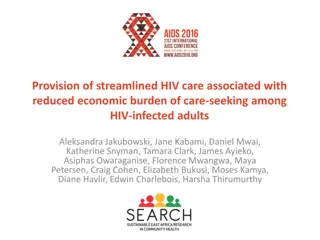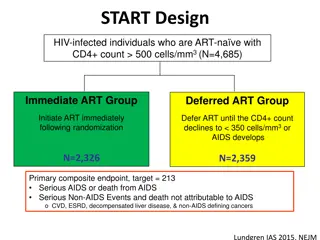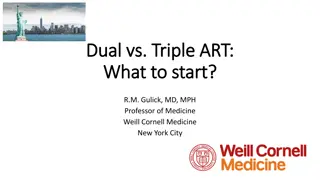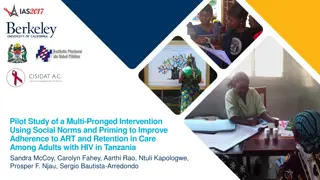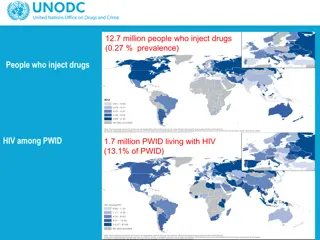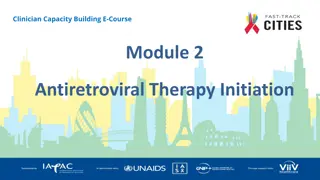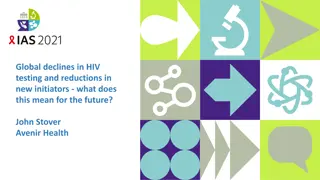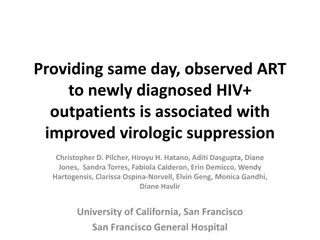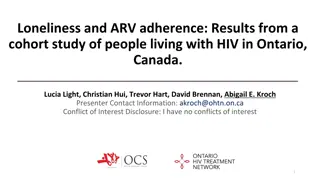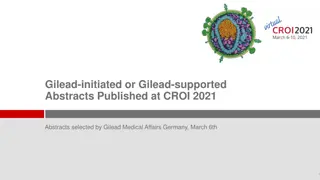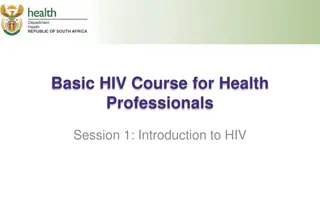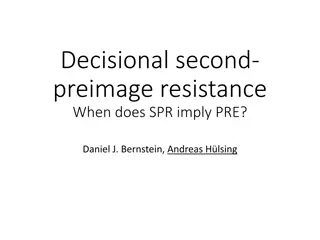Acquired HIV Drug Resistance Among Ugandan Adults on Antiretroviral Therapy
ART has transformed HIV care, yet drug resistance poses challenges. This study examines HIV drug resistance mutations in Ugandan adults on first and second-line regimens. Findings shed light on the impact and implications of acquired drug resistance in resource-limited settings.
Download Presentation

Please find below an Image/Link to download the presentation.
The content on the website is provided AS IS for your information and personal use only. It may not be sold, licensed, or shared on other websites without obtaining consent from the author.If you encounter any issues during the download, it is possible that the publisher has removed the file from their server.
You are allowed to download the files provided on this website for personal or commercial use, subject to the condition that they are used lawfully. All files are the property of their respective owners.
The content on the website is provided AS IS for your information and personal use only. It may not be sold, licensed, or shared on other websites without obtaining consent from the author.
E N D
Presentation Transcript
From From Antiretroviral Therapy Access to provision of Third Line regimens: evidence of Antiretroviral Therapy Access to provision of Third Line regimens: evidence of HIV Drug Resistance Mutations to first and second line regimens among Ugandan HIV Drug Resistance Mutations to first and second line regimens among Ugandan adults adults Dr Dr.Ivan Namakoola Ivan Namakoola on behalf of the CoLTART study on behalf of the CoLTART study team MRC/UVRI, MRC/UVRI, Entebbe team Entebbe
Background Antiretroviral therapy (ART) improves survival of HIV-infected individuals, reduces risk of AIDS and non-AIDS diseases and reduces HIV transmission Globally, numbers of new HIV infections and mortality due to AIDS are declining Acquired HIV drug resistance (HIVDR) limits sustained benefits of lifelong ART Revised ART guidelines in resource limited settings urge Routine viral load monitoring Drug resistance testing at treatment failure HIV Drug Resistance Surveillance in national programs HIV drug resistance profiling prior to initiating ART is not yet standard HIV care in resource limited settings
Background ART roll out in Africa began as an emergency response with no access to wide spread Viral Load monitoring to guide early ART switches In these conditions prolonged viral replication results in acquired HIVDR potentially compromising future treatment options We report on a cross-sectional cohort study to determine patterns of acquired HIVDR among 953 HIV infected adults who had been on ART for 6 or more months with a median of 9 years
Methods A cross-sectional study of HIV-Positive adults at enrolment into a prospective clinical cohort established to study the complications of long-term ART (CoLTART). We recruited individuals from two ART cohorts; The former Development of Antiretroviral Therapy in Africa (DART) Trial cohort established in 2003, and The former Rural Clinical Cohort in south western Uganda where ART was introduced in 2004. For each subject we obtained: ART history, CD4 count and Viral Load at cohort entry Genotyping was performed on every sample with HIV RNA viral load of 1000 copies/mL
Findings ,
Characteristics of subjects with viral loads 1000 copies/ml at cohort entry Characteristic All participants ART regimen First line ART n (%) 74 Second line ART n (%) 36 n (%) 110 All Sex Females Males Age, years 18-34 35-49 50+ HIV subtype A B C D CRF01_AE CD4 cell counts at cohort entry Cells/ml 73 (66.4) 37 (33.6) 53 (71.6) 21 (28.4) 20 (55.6) 16 (44.4) 15 (13.6) 72 (65.5) 23 (20.9) 6 (8.1) 50 (67.6) 18 (24.3) 9 (25.0) 22 (61.1) 5 (13.9) 37 (33.6) 5 (4.5) 6 (5.5) 38 (34.5) 24 (21.8) 25 (33.8) 3 (4.1) 5 (6.8) 22 (29.7) 19 (25.7) 12 (33.3) 2 (5.6) 1 (2.8) 16 (44.4) 5 (13.9) <=350 351 500 501+ Total duration on ART, years 65 (63.7) 26 (25.5) 11 (10.8) 41 (60.3) 22 (32.4) 5 (7.4) 24 (70.6) 4 (11.8) 6 (17.6) 0-<5 5-<9 9+ 15 (13.6) 6 (5.5) 89 (80.9) 9 (12.2) 2 (2.7) 63 (85.1) 6 (16.7) 4 (11.1) 26 (72.2) Duration on current ART regimen, years <5 5-<9 9+ 17 (17.5) 17 (17.5) 63 (64.9) 9 (12.2) 2 (2.7) 63 (85.1) 8 (34.8) 15 (65.2) 0 (0.0)
Commonest Clinically Significant Mutations DRM detected % of samples DRM detected % of samples DRM detected % of samples DRM detected % of samples Non Thymidine Analogue Mutations M184V 20.7% K65R 8.0% Thymidine Analogue Mutations NNRTI Mutations Major PI Mutations M41L 8.0% K103N 19.0% V82A 7.0% K70R 8.0% G190A 7.0% I54V 5.0% Y181C 6.0% M461I 5.0% L33I 5.0% Accessory PI resistance mutations L10I 27.0% L10V 12.0% L10F 5.0%
What this means for 2nd line treatment options Of the 7 patients with major PI DRMs 5 had high level resistance to Indinavir, Fosamprenavir, Atazanavir, Lopinavir and Nelfinavir 6 of the 7 retained susceptibility to Darunavir and 1 subject expressed low level resistance to Darunavir 2 subjects expressed susceptibility to Tipranavir Lopinavir and Atazanavir are the main PIs available for 2nd line treatment in Uganda and in other resource limited settings Darunavir is only available in limited centers in Uganda Tipranavir is not listed
Ugandas Revised ART Policy (2016) Routine VL monitoring to guide early ART switches is now recommended in Uganda, though not yet widely available In addition, we now recommend HIV phenotyping at 2nd line regimen failure to permit selection of effective ART for continued treatment Increased advocacy for access to 3rd line regimens is ongoing Revised Policy now includes introduction of Dolutegravir, a new class of ARV into national program
Acknowledgements CoLTART study participants This research was jointly funded by the UK Medical Research Council (MRC) and the UK Department for International Development (DFID) under the MRC/DFID Concordant agreement MRC/UVRI Research Unit CoLTART study team CDLS Laboratory Basic Sciences Laboratory Statistics Section
Thank you. Thank you.
